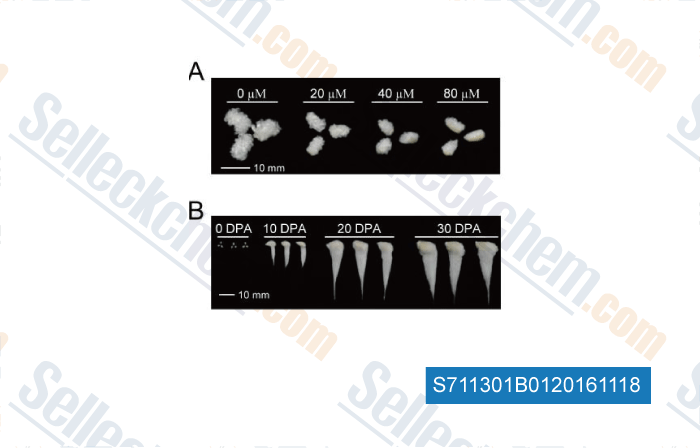|
Toll Free: (877) 796-6397 -- USA and Canada only -- |
Fax: +1-832-582-8590 Orders: +1-832-582-8158 |
Tech Support: +1-832-582-8158 Ext:3 Please provide your Order Number in the email. |
Technical Data
| Formula | C9H12N2O5 |
||||||
| Molecular Weight | 228.2 | CAS No. | 3690-10-6 | ||||
| Solubility (25°C)* | In vitro | DMSO | 46 mg/mL (201.57 mM) | ||||
| Water | 46 mg/mL (201.57 mM) | ||||||
| Ethanol | Insoluble | ||||||
| In vivo (Add solvents to the product individually and in order) |
|
||||||
|
* <1 mg/ml means slightly soluble or insoluble. * Please note that Selleck tests the solubility of all compounds in-house, and the actual solubility may differ slightly from published values. This is normal and is due to slight batch-to-batch variations. * Room temperature shipping (Stability testing shows this product can be shipped without any cooling measures.) |
|||||||
Preparing Stock Solutions
Biological Activity
| Description | Zebularine (NSC 309132, 4-Deoxyuridine) is a DNA methylation inhibitor that forms a covalent complex with DNA methyltransferases, also inhibits cytidinedeaminase with Ki of 2 μM in a cell-free assay. | ||||
|---|---|---|---|---|---|
| Targets |
|
||||
| In vitro | Zebularine is a cytidine analogue containing a 2-(1H)-pyrimidinone ring, originally synthesized as a cytidine deaminase inhibitor. [2] Zebularine is shown to form a tight, covalent complex with bacterial methyltransferases. [1] In N. crassa, zebularine inhibits DNA methylation and reactivates a gene previously silenced by methylation. Zebularine is a global inhibitor of DNA methylation, similar to 5-Aza-CR, rather than a selective inhibitor. Zebularine induces the myogenic phenotype in 10T1/2 cells, which is a phenomenon unique to DNA methylation inhibitors. Zebularine reactivates a silenced p16 gene and demethylates its promoter region in T24 bladder carcinoma cells. Zebularine is only slightly cytotoxic to T24 cells. [3] Zebularine is preferentially incorporated into DNA and exhibits greater cell growth inhibition and gene expression in cancer cell lines compared to normal fibroblasts. In addition, zebularine preferentially depletes DNA methyltransferase 1 (DNMT1) and induces expression of cancer-related antigen genes in cancer cells relative to normal fibroblasts. [4] | ||||
| In vivo | Zebularine is only slightly cytotoxic to tumor-bearing mice (average maximal weight change in mice treated with 1000 mg/kg zebularine = 11% [95% CI = 4% to 19%]). Compared with those in control mice, tumor volumes are statistically significantly reduced in mice treated with high-dose zebularine administered by intraperitoneal injection or by oral gavage. [3] | ||||
| Features | Very stable with half-life of ~44 h at 37°C in PBS at pH 1.0 and approx. 508 h at pH 7. |
Protocol (from reference)
| Animal Study:[3] |
|
|---|
References
Customer Product Validation

-
Data from [Data independently produced by , , Nucleic Acids Res, 2016, 44(9):4067-79.]
Selleck's Zebularine (NSC 309132) has been cited by 13 publications
| A role of epigenetic mechanisms in regulating female reproductive responses to temperature in a pest beetle [ Insect Mol Biol, 2024, 10.1111/imb.12933] | PubMed: 38864655 |
| Preclinical efficacy of azacitidine and venetoclax for infant KMT2A-rearranged acute lymphoblastic leukemia reveals a new therapeutic strategy [ Leukemia, 2022, 10.1038/s41375-022-01746-3] | PubMed: 36380143 |
| Low mitochondrial DNA copy number induces chemotherapy resistance via epithelial-mesenchymal transition by DNA methylation in esophageal squamous cancer cells [ J Transl Med, 2022, 20(1):383] | PubMed: 36038893 |
| DNA hypermethylation promotes the flowering of orchardgrass during vernalization [ Plant Physiol, 2022, 190(2):1490-1505] | PubMed: 35861426 |
| Zebularine, a DNA Methylation Inhibitor, Activates Anthocyanin Accumulation in Grapevine Cells [ Genes (Basel), 2022, 13(7)1256] | PubMed: 35886036 |
| miR-497-5p/SALL4 axis promotes stemness phenotype of choriocarcinoma and forms a feedback loop with DNMT-mediated epigenetic regulation [ Cell Death Dis, 2021, 12(11):1046] | PubMed: 34732693 |
| Epigenetic reduction of miR-214-3p upregulates astrocytic colony-stimulating factor-1 and contributes to neuropathic pain induced by nerve injury. [ Pain, 2020, 161(1):96-108] | PubMed: 31453981 |
| Ovarian hormones induce de novo DNA methyltransferase expression in the Siberian hamster suprachiasmatic nucleus. [ J Neuroendocrinol, 2020, 32(2):e12819] | PubMed: 31800973 |
| Multi-omics analyses reveal epigenomics basis for cotton somatic embryogenesis through successive regeneration acclimation process [Li J, et al. Plant Biotechnol J, 2018, 10.1111/pbi.12988] | PubMed: 29999579 |
| Disrupted Genome Methylation in Response to High Temperature Has Distinct Affects on Microspore Abortion and Anther Indehiscence. [ Plant Cell, 2018, 30(7):1387-1403] | PubMed: 29866646 |
RETURN POLICY
Selleck Chemical’s Unconditional Return Policy ensures a smooth online shopping experience for our customers. If you are in any way unsatisfied with your purchase, you may return any item(s) within 7 days of receiving it. In the event of product quality issues, either protocol related or product related problems, you may return any item(s) within 365 days from the original purchase date. Please follow the instructions below when returning products.
SHIPPING AND STORAGE
Selleck products are transported at room temperature. If you receive the product at room temperature, please rest assured, the Selleck Quality Inspection Department has conducted experiments to verify that the normal temperature placement of one month will not affect the biological activity of powder products. After collecting, please store the product according to the requirements described in the datasheet. Most Selleck products are stable under the recommended conditions.
NOT FOR HUMAN, VETERINARY DIAGNOSTIC OR THERAPEUTIC USE.
